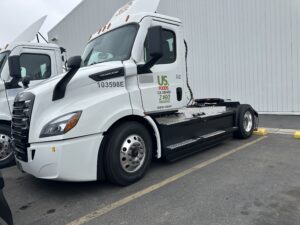
This 2026 Freightliner Cascadia VIN Verification was done by our team member in La Mirada, Ca. on 09/26/2025

This 2026 Freightliner Cascadia VIN Verification was done by our team member in La Mirada, Ca. on 09/26/2025
The 2026 Freightliner Cascadia is the fifth‑generation model of Freightliner’s flagship Class 8 highway tractor. Unveiled in late 2024, it represents a significant update over the previous Cascadia, with improvements focused on safety, aerodynamics, efficiency, and connectivity.
The Cascadia line was first introduced in 2007 to be Freightliner’s benchmark for long‑haul trucks, emphasizing driver comfort, reliability, and fuel efficiency.
Over its lifetime, the Cascadia has gone through several generations, each bringing incremental improvements in powertrain, aerodynamics, and safety. The most recent major redesign is the fifth generation, which is entering production in mid‑2025 for the 2026 model year.
Freightliner (part of Daimler Truck North America) has built over one million units of Cascadia trucks since its original launch, making it one of the most common Class 8 tractor models in North America.
Engine options include:
Detroit DD13: ~370‑525 hp; torque ratings up to about 1,850 lb‑ft.
Detroit DD15: typically higher output, in the range of 425‑505 hp and also up to ~1,850 lb‑ft torque.
Cummins X15 and Cummins X15N (natural gas version) are expected / upcoming offerings. X15 yields up to ~605 hp and ~2,050 lb‑ft in some configurations.
Transmission options:
Automated manual — e.g. the Detroit DT12 series
“Other automated manuals” like the Eaton Cummins Endurant 12‑speed appear in spec sheets, especially with the natural gas variants.
Chassis / drivetrain:
Available in various axle configurations: tandem drives (6×4), many front and rear axle weights to suit heavy‑haul loads.
Aerodynamics: significant updates include a new hood design, redesigned A‑pillar deflector, three‑piece front wheel well closeouts, hood‑to‑bumper sealing, bumper air ducts for improved airflow, and the optional Max Aero Bumper. These help reduce drag and improve fuel economy.
Exterior lighting & visibility: Dual‑stage intelligent LED headlights (auto‑high beam, better beam pattern, de‑icing/defogging) and the factory‑installed MirrorCam System (cameras instead of traditional side mirrors) for better visibility and reduced drag.
Interior / connectivity: Enhanced cab insulation (noise, thermal), modern dashboard with digital/digital‑analog displays, touchscreen infotainment with Apple CarPlay / Android Auto, better HVAC flow, upgraded telematics (Detroit Connect), amenities in sleeper cabs (e.g. double bunks, optional refrigerators, inverters/APU for idle‑free climate control).
Cab configurations:
Day Cab: shorter wheelbases, no sleeper. Available with 116‑inch or 126‑inch BBC (bumper to back of cab) configurations.
Sleeper Cabs:
Mid‑roof XT options: 48″, 60″, or 72″ sleepers (for both 116″ & 126″ BBC)
Raised roof sleepers: 60″ or 72″ options on 116″ or 126″ BBCs.
Powertrain / fuel type variants:
Diesel engines (Detroit, Cummins) dominate initially.
Natural gas variant via Cummins X15N will be offered for the Cascadia Natural Gas version.
Optional packages:
Elite exterior / interior packages (upscale finishes, more chrome, upgraded seats/materials)
Lightweight packages (lighter components, aluminum etc.)
Sleepers with enhanced amenities (inverter/APU, refrigerator, etc.)
Safety suite: Freightliner’s Detroit Assurance Suite gets upgraded:
Active Brake Assist 6 (ABA6) — better detection (including stationary pedestrians, vehicles stopped at odd angles, etc.)
Active Lane Assist 2 (ALA2) — now includes Lane Change Assist; Attentive Driver Protection monitors driver input, can slow truck, hazard lights if driver unresponsive.
Side Guard Assist 2 (SGA2) — now detects on both driver and passenger sides, from cab through trailer.
Braking & stability:
New Intelligent Braking Control System (IBCS): brake‑by‑wire with backup pneumatics, comfort braking, lining wear control, performance monitoring, “Endurance Braking”. Electronic park brake with rollaway mitigation.
Visibility & lighting:
Dual‑stage intelligent LED headlamps; MirrorCam; automatic wipers/headlamps; high‑beam control.
Telematics & driver assistance:
Detroit Connect Video Capture 2.0 (records safety events), remote lock/unlock, geofencing, safety status monitoring.
Compared to original Cascadia, over 35% improvement in fuel efficiency across generations so far; the 2026/5th‑gen adds more for aerodynamics.
From the aerodynamic upgrades alone, Freightliner claims about a 1.9% fuel economy benefit over the previous generation.
Natural gas variant (X15N) will presumably offer lower emissions, possibly better cost per mile depending on fuel infrastructure and pricing.
In the Class 8 long haul segment, its competitors include trucks from Volvo (e.g. VNL series), Kenworth (e.g. T680), Peterbilt (579), and others. Freightliner Cascadia has been among the best‑selling long haul tractors in NA.
Key advantages: strong safety feature set, aerodynamics, driver comfort, broad engine options, fleet telematics. Potential disadvantages: higher cost of advanced features, possibly complexity of maintenance due to increased sensors / electronics.
Fuel efficiency improvements, safety systems, and driver assist technologies are becoming table stakes; Cascadia’s updates help it stay competitive.
Examples of pricing in dealer listings:
A fully equipped 2026 Cascadia 126 with premium features (72″ double bunk, Detroit DD15 455 hp, aluminum wheels, etc.) is listed at US$229,900 in one dealer ad.
Another with a 505 hp DD15, raised roof sleeper, etc. priced at about US$193,900.
Another listing: $197,900 for a similar spec.
Base price (without premium trim / options) is lower, but specific MSRP isn’t clearly published for every configuration yet.
Price will vary with trim, options, powertrain, region, dealer markups, etc.
While specific awards for the 2026 model may not yet be fully recorded (given its recent introduction), the Cascadia line has been repeatedly recognized in industry rankings for driver satisfaction, resale value, and fuel efficiency in past years.
The unveiling of the fifth‑generation was presented by Freightliner as setting “new standards in safety, efficiency, and profitability.”
Its safety suite enhancements, aerodynamic improvements, and telematics gains are being praised in trade media, indicating strong reception.